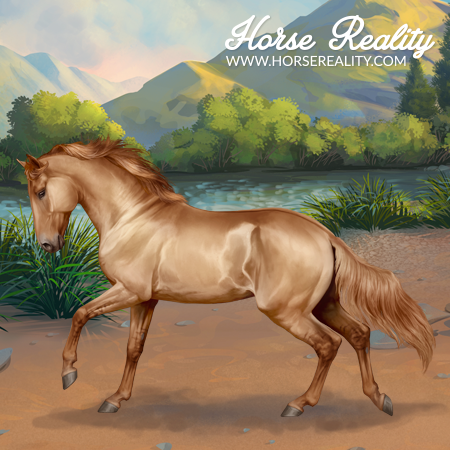The Pantaneiro is a breed available in the Horse Reality game, that can be caught in the South American Wildlife Park.
| Pantaneiro Horse | |
|---|---|

|
|
| General Information | |
| Origin | Brazil |
| Horse Reality | |
| Colours | Chestnut, Black, Bay, Seal Brown, Flaxen, Sooty, Grey, Cream, Dun, Non-Dun1 |
| Whites | White Markings, Roan |
| Height | 135 - 150cm |
| Registry | Pantaneiro Horse Society |
| Alternative names | Panta, Panty |
| Origin | South American Wildlife Park |
| Status | In-game (2023) |
| Artists | |
| Lineart | H. Hegele (2023) |
| Greyscale | D. Grochowska, H. Hegele (2023) |
| Colours & patterns | H. Hegele (2023) |
¶ Conformation
The Pantaneiro Horse is a breed that for a few centuries had little to no human interference and became well-adapted to its environment. Therefore, the breed's conformation is focused on efficient travelling over long distances in harsh conditions of marshlands. Their neck is short and broad, chests are deep and long. The same height of withers and croup makes the breed suitable for walking. Legs are dry with exceptionally strong hooves[1].
¶ Colour Genetics
This feral breed comes in a lot of base colours with only wild bay being excluded. Amongst wild horses dun and cream dilutions are present but not many can be seen as almost 40% of horses are grey[2]. There's also evidence of three colour modifiers appearing: flaxen, sooty, and non-dun1.
This breed doesn't have many white patterns as only roan can be rarely spotted.
¶ Alleles
All alleles available for the breed can be found below highlighted in green. For better clarity, we bolded alleles that impact coat colours (eg. grey G vs non-grey g).
| Base Colours & Modifiers | ||
|---|---|---|
| Extension | Agouti | Grey |
| E, e | A, At, a | G, g |
| Dilutions | ||||
|---|---|---|---|---|
| Cream-Pearl | Dun | Champagne | Silver | Mushroom |
| CR, n | D, nd1, nd2 | ch | z | n |
| White Patterns | |||||
|---|---|---|---|---|---|
| Frame | Appaloosa | PATN1 | MITF | SW2 | KIT |
| n | lp | patn1 | n | sw2 | RN, n |
Please note that the table includes a hidden agouti allele (At). Besides testable genes, there are also untestable genes present: sooty, flaxen, and white markings (head markings, socks, etc.).
¶ Artwork Updates
The Pantaneiro was released on May 24th 2023.[3] This breed has a complete set of genes and alleles.[4]
¶ Breed in Real Life
The Pantaneiro Horse lives in the Pantanal, a region of floodplains located in Brazil. The breed's origin is unknown but history indicates that the Pantaneiro Horse derives from horses brought by Spanish conquerors in the 16th and 17th centuries. At the same time, scientific evidence suggests that Portuguese-origin ancestry influenced the breed[5]. It is also believed that horses originating from the Iberian Peninsula were brought into the Pantanal by the Guaicuru people where wild horses had to adapt to the harsh conditions of freshwater marshlands. For more than two centuries natural selection with little to no human interference allowed horses to become well-adapted to wetlands. With time the breed became important to local cattle breeders. Sadly, at the end of the 19th century, the Pantaneiros suffered a severe population size reduction due to a disease. Followed by crossbreeding and equine infectious anemia the problems left the population troubled with survival. There are active conservation efforts trying to preserve the breed led by the Brazilian Pantaneiro Horse Breeders Association and other governmental institutions[6]. Thanks to them, the breed is no longer endangered, but it still has a vulnerable status[2].
¶ References
- Concepta, M. M., et al. "Body indices for the Pantaneirohorse." Braz. J. Vet. Res. Anim. Sci 45.5 (2008): 362-370.
- Santos, S. A., et al. "A review of Conservation and Management of the Pantaneiro horse in the Brazilian Pantanal." Animal Genetic Resources/Resources génétiques animales/Recursos genéticos animales 31 (2001): 75-86.
- https://v2.horsereality.com/news/135/community-update-pantaneiro-horse-release-contest-winners-foundation-batch-2-more
- https://deloryan.notion.site/Horse-Breeds-Artwork-Genetics-6d0a84be35284b12806976bbb8cc886c
- Cothran, E., et al. "Genetics of the Pantaneiro horse of the Pantanal region of Brazil." Genetics and Molecular Biology 21 (1998): 343-349.
- Santos, S. A., et al. "Origin of the Pantaneiro horse in Brazil." Arch. Zootec 41 (1992): 371-381.